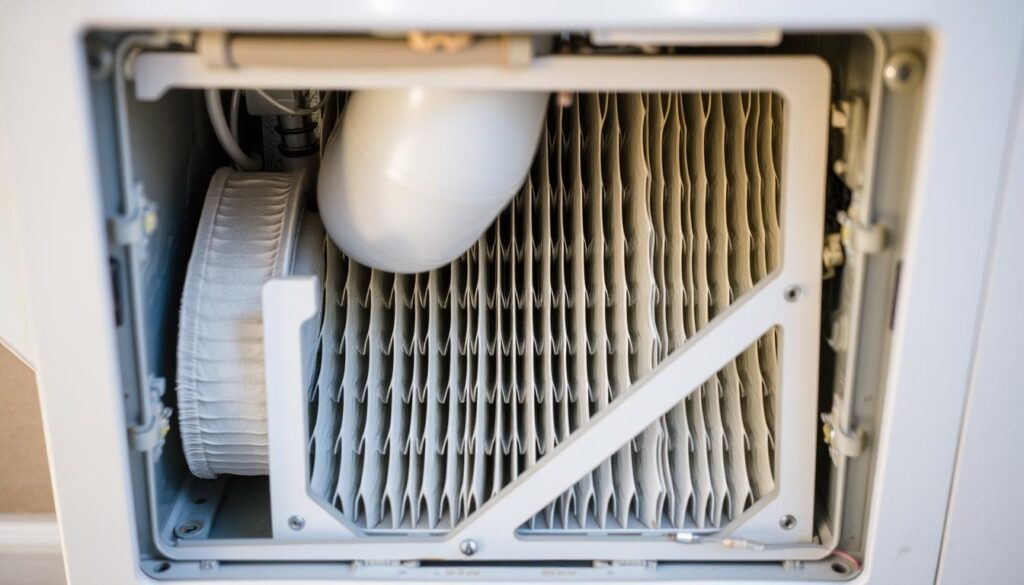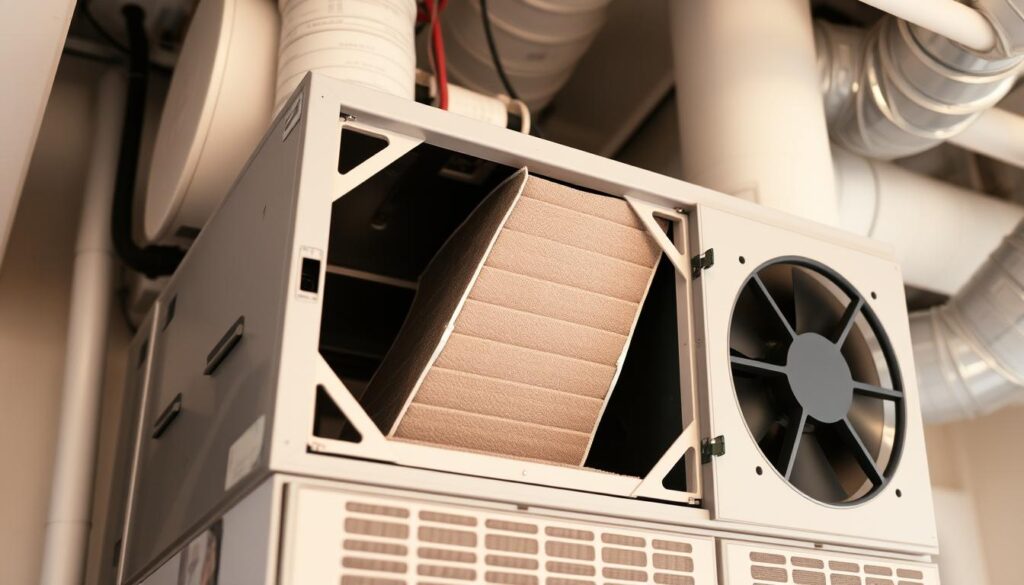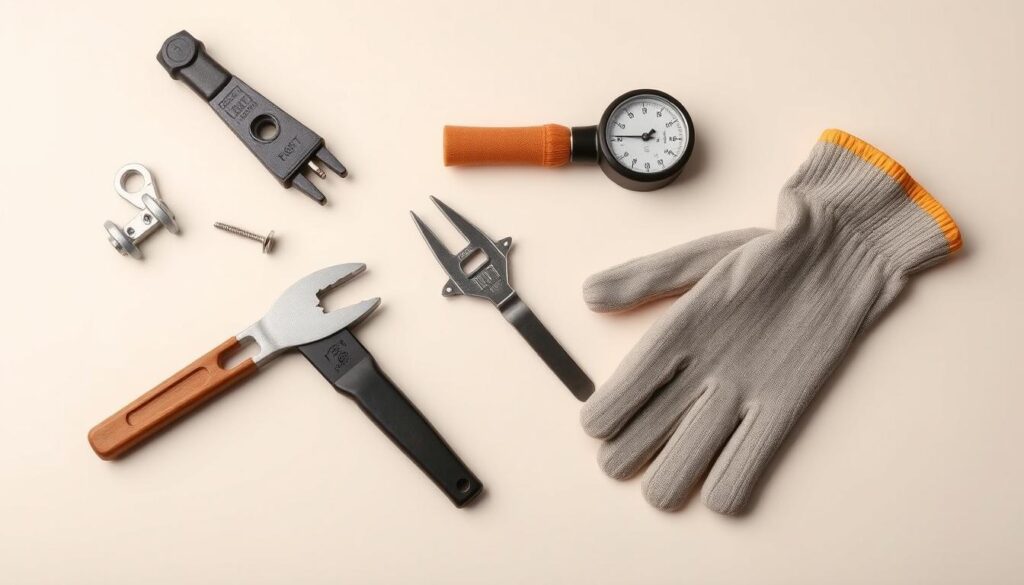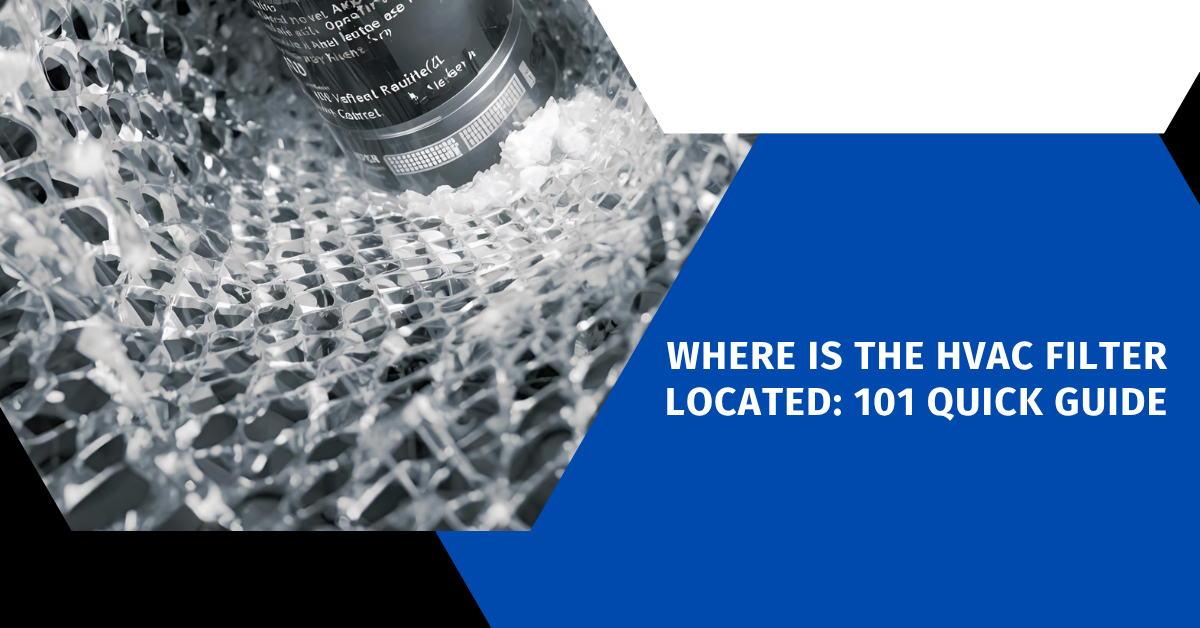Affiliate Disclosure
HVAC Guide Guys is a participant in the Amazon Services LLC Associates Program, an affiliate advertising program designed to provide a means for sites to earn advertising fees by advertising and linking to Amazon.
Where Is the HVAC Filter Located? Ever wondered where your home’s HVAC filter is? Knowing where it is can greatly improve your air quality and system performance.
Finding your furnace filter might seem tricky. But it’s key to keeping your HVAC system in top shape. Whether you’re new to homeownership or want better air, knowing where the filter is is vital.

Most people find it hard to locate their HVAC filter. It’s usually between one and five inches thick. This guide will show you where to look, ensuring your system works best.
Key Takeaways
- HVAC filters are critical for maintaining indoor air quality
- Filter locations vary depending on your home’s HVAC system type
- Regular filter maintenance prevents system inefficiency
- Filter placement impacts overall system performance
- Knowing your filter’s location saves time and money
Table of Contents
Understanding the Importance of HVAC Filter Location
Knowing where your HVAC filter is is key to a healthy home. Experts say regular maintenance is vital for your system to work well.
Your HVAC system works hard to keep your home comfy. But, it needs the right filter care to do its job well. The Environmental Protection Agency (EPA) offers important tips on keeping your filter clean.
“A clean filter is the heart of an efficient HVAC system” – HVAC Maintenance Professionals
Benefits of Regular Filter Maintenance
- Improves indoor air quality
- Reduces energy consumption
- Extends HVAC system lifespan
- Prevents costly system breakdowns
Impact on Air Quality and System Efficiency
Clean filters are essential for removing allergens and pollutants from your air. A well-kept filter boosts your system’s efficiency and air quality.
| Filter Condition | Air Quality Impact | Energy Efficiency |
|---|---|---|
| Clean Filter | Excellent | High |
| Dirty Filter | Poor | Low |
Cost Savings Through Proper Filter Care
Regular filter care can save you money. By avoiding system strain and cutting energy use, you could save hundreds a year on bills and repairs.
The EPA suggests checking your air filter monthly and replacing it every three months. This simple action can greatly improve your home’s air and HVAC system performance.
Common HVAC Filter Locations in Your Home
Homeowners often find different spots for air handler filters in their HVAC systems. Knowing where these filters are helps keep your system running well and clean.
Your HVAC filter could be hidden in several important places in your home. These spots are chosen to improve air filtration and system efficiency.
- Return air ducts near wall or ceiling openings
- Blower compartment inside the air handler
- Behind return air grilles in various rooms
- Utility closets with HVAC equipment
Different homes have filters in different places. Older homes might have filters in different spots than newer homes. Newer homes often have more advanced HVAC systems.
| Location Type | Accessibility | Typical Filter Size |
|---|---|---|
| Return Air Duct | Easy | 16×20 inches |
| Blower Compartment | Moderate | 14×25 inches |
| Return Air Grille | Simple | 10×16 inches |
Pro tip: Always check your specific HVAC system’s manual for exact filter location and recommended replacement schedule.
Explore Our HVAC Shop
Looking for top-rated HVAC tools, parts, and accessories? Visit our shop and find the perfect solution for your needs.
Visit the ShopWhere Is the HVAC Filter Located: Main Access Points
Finding the HVAC filter can save you time and improve your home’s air quality. Different HVAC systems place filters in unique spots. Knowing these spots helps you keep your system running well.
- Return Air Ducts
- Blower Compartments
- Return Air Grilles
Exploring Return Air Duct Locations
The return air duct is key for finding the ac filter. These ducts connect to your furnace or air handler. Look for a big, rectangular opening near your HVAC unit. Here, filters slide in and out easily.
Blower Compartment Placement
The blower compartment is another common spot. It’s usually inside the air handler, where the fan and motor are. Open the panel carefully to find and replace the filter.
Behind Return Air Grilles
Some homes have filters behind return air grilles on walls or ceilings. You can remove these grilles with a screwdriver. Inside, you’ll find the filter. Check all return vents to keep your system in top shape.
Pro Tip: Always note the airflow direction arrow when reinstalling your filter to ensure proper installation.
Finding Filters in Different HVAC System Types
Knowing where to find filters in your HVAC system can save you time and hassle. Each type of HVAC system has its own way of placing filters. This depends on its design and how it’s installed.
Your home might have one of several common HVAC systems. Each has its own way of placing filters:
- Split Systems: Filters are usually in the return air duct or blower compartment
- Packaged Units: Filters are often near the air handler
- Ductless mini-splits: Filters are built into the indoor units
Split system HVAC units are the most common in homes. They have filters in two main places:
- Return Air Duct: Near the main indoor unit
- Blower Compartment: You can find it behind a removable panel
“Knowing your specific HVAC system type is key for good filter maintenance and air quality.” – HVAC Professional Recommendation
Packaged units, found in apartments or small homes, are easier to access. They have a filter slot that’s simple to get to and replace during maintenance.
| HVAC System Type | Typical Filter Location | Accessibility |
|---|---|---|
| Split System | Return Air Duct/Blower Compartment | Moderate |
| Packaged Unit | Near Air Handler | Easy |
| Ductless mini-split | Inside Indoor Unit | Very Easy |
If you’re not sure where your filters are, check your system’s manual or ask an HVAC expert. Changing filters regularly is important for your system’s efficiency and air quality.
Locating Filters in Horizontal vs Vertical Units
Knowing where to find the filter in horizontal and vertical HVAC units is key. Each type has its own filter spot, based on its design.
Looking for the HVAC filter? You’ll find it in two main places: horizontal and vertical units. These spots are different because of how the units are set up.
Horizontal Unit Filter Placement
Horizontal HVAC units have filters in certain spots:
- Inside a return air duct
- Next to the air handler
- In a special filter box
Vertical Unit Filter Positioning
Vertical units have filters in other places:
- Up top in a slot
- At the bottom in a special box
- Inside return air grilles
Installation Location Variations
Where the filter is can change based on your home:
| Installation Area | Typical Filter Location | Access Difficulty |
|---|---|---|
| Attic | Near air handler | Moderate |
| Basement | Beside furnace | Easy |
| Crawl Space | Inside return air duct | Challenging |
| Utility Closet | Next to HVAC unit | Easy |
Pro tip: Always check your HVAC system’s manual for exact filter location. It will be specific to your unit and setup.
Explore Our HVAC Shop
Looking for top-rated HVAC tools, parts, and accessories? Visit our shop and find the perfect solution for your needs.
Visit the ShopAir Handler Filter Placement Guide

Finding the air handler filter is key to good HVAC care. It’s usually in a central spot like a basement, utility closet, or attic. Knowing where it is helps keep your air clean and your system running well.
When looking for air handler filters, check these spots:
- Blower compartment near the main unit
- Large intake air duct entrance
- Dedicated filter housing within the system
Most air handlers have a panel or slide-out filter area. Safety is important when checking the filter. Always switch off your HVAC before you open it to avoid electrical risks.
Home designs vary, so air handler spots differ too. In older homes, filters might be behind return air grilles. Newer systems often have easier-to-reach filters with clear signs.
Pro tip: Check your filter every 30-90 days and replace it when it’s dirty to keep your system efficient.
Keeping your filter clean boosts air quality. It also makes your HVAC last longer and cuts down on energy bills.
Return Vent Filter Locations Throughout Your Home
Finding all the return vent filters in your home is key to your air filter replacement guide. Some HVAC systems have many return vents. This means you need a detailed plan for changing your central air filter.
Different homes have unique HVAC systems. This affects where filters are placed. Knowing your system’s design is important for good filter care.
Exploring Multiple Return Vent Strategies
Homes with complex HVAC systems might have return vents in different places:
- Living room walls
- Hallway ceilings
- Bedroom closets
- Utility room spaces
Room-by-Room Filter Inspection Approach
To keep the air in your home clean, follow these steps for changing your central air filter:
- Create a comprehensive home filter map
- Check each return vent one by one
- Record filter sizes and when they need to be replaced
- Replace filters on a regular schedule
Experts say to check all return vents every three months. This keeps your system running well. It also helps avoid air quality problems and makes your HVAC last longer.
Signs Your Filter Needs Replacement
Knowing when to replace your HVAC filter is key for clean air and system health. Regular checks can spot issues early, saving you money.
Your HVAC system gives clear signs when it’s time for a new filter. Keep an eye out for these signs during your maintenance routine:
- Visible dust on vents
- Less airflow from vents
- Higher energy bills
- Worsening allergies or poor air quality
Just by looking, you can tell if your filter needs a change. Check if light can pass through or if it’s gray and dirty. If not, it’s time for a new one.
| Filter Condition | Recommended Action |
|---|---|
| Clean, white/off-white appearance | Filter is fine |
| Gray, dark, or dirty | Replace it now |
| Can’t see through when held up to light | Replace it right away |
Things like pet hair, dust from construction, or pollen can make filters dirty faster. Most filters need to be changed every 60-90 days. But, if you have pets or allergies, you might need to change them more often.
Pro tip: Set calendar reminders or mark filter replacement dates directly on your new filter to ensure consistent maintenance.
Explore Our HVAC Shop
Looking for top-rated HVAC tools, parts, and accessories? Visit our shop and find the perfect solution for your needs.
Visit the ShopTools Needed for Filter Location and Replacement
Getting ready for an HVAC filter replacement is all about planning and the right tools. Your air filter replacement guide begins with getting the essential tools. This makes the process smooth and efficient. Proper preparation is key to keeping your system running smoothly.

Before starting, gather these tools for a successful filter replacement:
- Flathead or Phillips screwdriver
- New HVAC filter (matching your system’s exact size)
- Trash bag for disposing of the old filter
- Work gloves
- Dust mask (optional but recommended)
Essential Safety Precautions
Safety is always first when doing HVAC maintenance. Follow these important steps to avoid hazards:
- Turn off the HVAC system completely at the circuit breaker
- Wear protective gloves to avoid dust and debris
- Use a dust mask if you have allergies or sensitivity
- Ensure proper lighting in your work area
Additional Preparation Tips
When accessing your filter, take extra care to:
- Check the filter’s size before purchasing a replacement
- Keep the area around the filter clean
- Handle the filter gently to avoid damage
Pro Tip: Always have a replacement filter on hand before starting the removal process to minimize system downtime.
Troubleshooting Hidden Filter Locations
Finding the furnace filter can be tough, leading you to hidden spots in your home. Many people have trouble finding the hvac filter, mainly in older or unique homes.
Start by looking in these often-missed places:
- Basement utility rooms
- Attic spaces
- Utility closets
- Behind rarely opened access panels
Look for a narrow slot, about one inch wide, with a hinged or removable cover. Some HVAC systems hide filters in spots that aren’t easy to see.
Here are some tips to find hidden filters:
- Check around the air handler or furnace unit
- Examine return air vents carefully
- Follow the ductwork path
- Feel for possible filter access points
Pro tip: If you can’t find the filter, check your HVAC system’s manual or call a professional for help.
Remember, every minute you spend looking for your HVAC filter can save you a lot of money and make your system work better.
Explore Our HVAC Shop
Looking for top-rated HVAC tools, parts, and accessories? Visit our shop and find the perfect solution for your needs.
Visit the ShopProfessional Tips for Filter Identification
Finding the right HVAC filter can seem like a big challenge. Your home’s air quality depends on knowing about merv rating filter placement and following smart hvac maintenance tips. HVAC technicians say picking the right filter is all about precision and knowledge.
When looking for the perfect filter, keep these important points in mind:
- Check your home’s air quality needs
- Learn about MERV ratings from 1-16
- Choose a filter that fits your system’s needs
- Follow the manufacturer’s advice
Pro tip: Higher MERV ratings aren’t always better. Filters with ratings between 8-11 are usually best for homes. Ratings above 13 can make your HVAC work too hard.
“Knowing your filter is like understanding your home’s respiratory system.” – HVAC Professional
Your filter choice should consider your home’s special needs like:
- Do you have pets?
- Are there allergies in your home?
- What’s the local air quality like?
- How many people live in your home?
Regular upkeep and smart filter placement can really boost your system’s performance and air quality. Always talk to a pro to find the best filter for your HVAC system.
Conclusion
Knowing where your HVAC filter is can really improve your home’s air and system performance. Your HVAC system needs the right filter to work well. Changing filters often keeps your system running smoothly and your air clean.
Smart HVAC maintenance tips can make your system last longer. Just check your filter every few months and change it when needed. This simple step can save you money and keep your system working great all year.
Understanding where your HVAC filter is lets you control your home’s air quality. Whether it’s in the return air duct or behind a grille, knowing its spot makes upkeep easy. Get to know your system and stick to a regular filter change schedule.
By taking care of your HVAC filter, you’ll enjoy better air, save on energy, and extend your system’s life. Don’t wait for issues to start—begin your filter care today. You’ll feel better knowing your home’s air system is in top shape.

